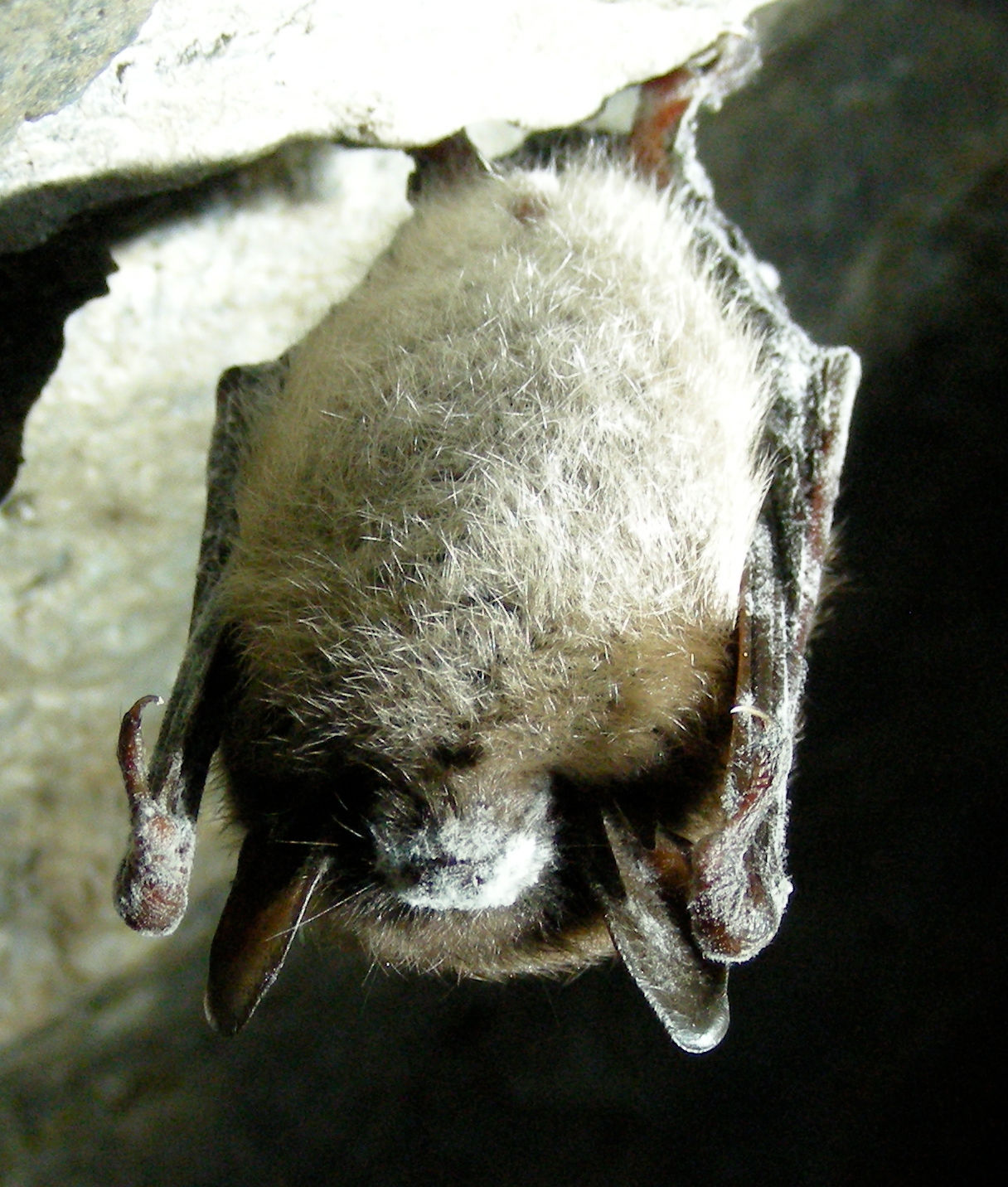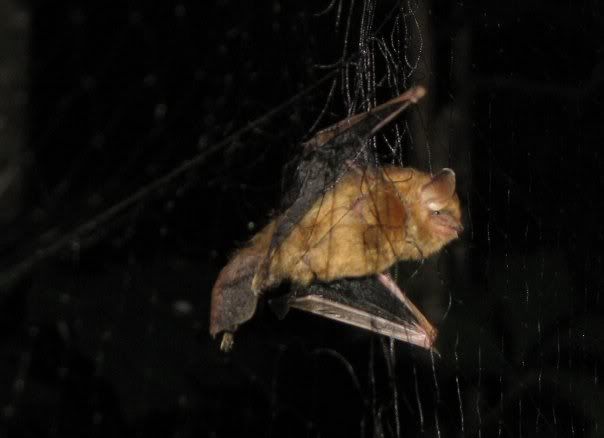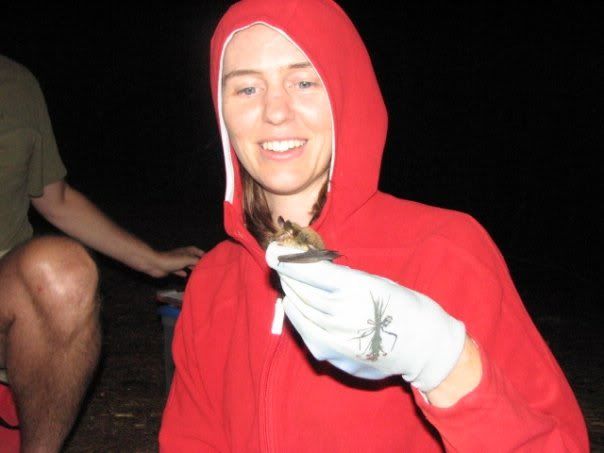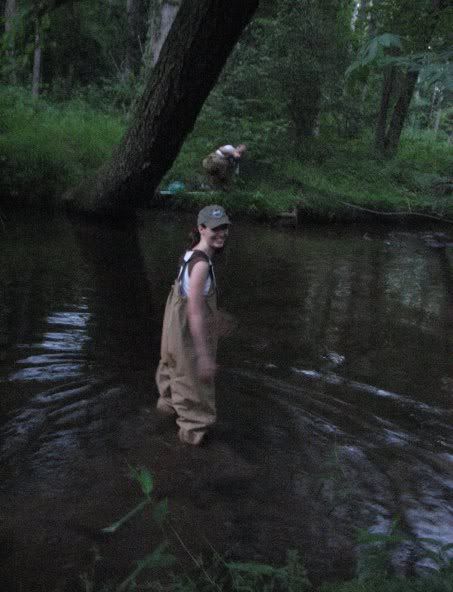How to Help Bats Succumbing to White Nose Syndrome
GoBlueRidge.net and the North Carolina Wildlife Resources Commission are reporting that bat White Nose Syndrome (WNS) was recently found in an old Avery County, NC mine as well as a cave in nearby Grandfather Mountain State Park.This marks the first sightings of the disease in NC and brings it even closer to my region of South Carolina. The bat population of upper SC was looking healthy but that could change before this year’s spring bulbs emerge.
Deadly WNS spreads so rapidly (as much as 450 miles in one winter) that bats may be a distant memory for the entire Appalachias and east coast in as little as 20 years. First discovered in 2006, it is already documented in 16 U.S. states and 2 Canadian provinces.

Photo Caption: Recently discovered White Nose Syndrome (WNS) is the likely culprit of mass bat deaths in North America. Named for the white smut that appears on the infected noses of bats, it can also infect their ears and wing membranes. The little brown bat (Myotis lucifugus) shown in this photograph is the most common insectivorous bat in North America and likely to be regionally extinct within a couple of decades. Credit: Wikipedia
I generally like fungus but the newly discovered and appropriately named Geomyces destructans is not on my list of favorite species. Scientists are scrambling to collect data on Geomyces destructans ever since it showed up as White Nose Syndrome in 2006. They believe that its native hosts may be European bats who have developed a resistance to it. This mirrors the invasive chestnut blight that wipes out American trees but does not destroy the Asian species it evolved with.
The definitive verdict of how WNS kills bats is out, but scientists think that the fungus interrupts the hibernating torpor of bats and causes them to use up fat stores too quickly. It also seems to lower their immune system, damage their wings, and cause detrimental behavior such as freezing winter flights.
Like rabies, scientists think WNS may be carried from bat to bat and cave to cave. It could also be transmitted on the bodies, clothing, and equipment of spelunkers which is why caves in some areas are closed to human activity.
This is a tough blow to a highly educational and rewarding hobby. The GoBlueRidge.net article quotes Sue Cameron of the US Fish & Wildlife Service as saying, “Cavers are passionate about what they do and we truly understand that asking them to stay out of caves is no small request and we greatly appreciate their sacrifice.”

Photo Caption: CLICK FOR MORE DETAILS. Map of white nose syndrome sightings. Credit: Bat Conservation International
This regional map shows reported and confirmed cases of WNS in chronological order. The purple splotches show areas where sightings have happened in the winter of 2011. The North Carolina cases occurred around 100 miles from the South Carolina border.
In some places on the map the death toll is almost 100% of the population. Since bats are long-lived mammals that only bear one pup per year, it is unlikely their numbers will ever recover from the blow.

Photo Caption: This tri-color bat (Perimyotis subflavus) was formerly known as the Eastern pipistrelle bat (aka Pipistrellus subflavus). I helped catch it at Paris Mountain State Park in June 2009.
I’ve taken advantage of the fact that I’m rabies vaccinated to participate in bat studies and conservation efforts. Sometimes that involved volunteering with wildlife rehabilitation groups but one of the most rewarding experiences was assisting a Furman University professor to collect bat data in our region.
Two things of note:
- Even if you are rabies vaccinated you still need a booster if you get exposed again (the shots aren’t as bad as they used to be… but that’s a low bar. However, no matter how much you hate needles it’s still better than death by encephalitis).
- A huge chunk of “bat study time” involves waiting on the bats to show up. It’s sort of like fishing. Because of this, I am now a talented Pass the Pigs player — the standard of nighttime forest entertainment for the group of scientists I accompanied.
To capture bats we erected large, finely woven nets in likely bat thoroughfares, usually near open water where flying insects collect. A machine that picks up bat sonar and reports it in tones audible to the human ear made it possible for us to tell when they were in the vicinity. Hearing one didn’t mean it was headed for the trap so we often scanned the net with a flashlight to see if a grumpy bat was dangling there like a spider’s meal.
Once captured, the net was lowered with a pulley so the bat could be gently disengaged from the threads. A methodical routine was followed where we identified the species and sex of bat, took measurements, checked its condition (especially for WNS), took a hair sample, and wing tagged it prior to release. All of these activities required a permit, especially in the state parks. Our major goal at the time was recording present species for the state park’s bioblitz. Then a tightly localized field guide could be made available to park staff and the public. Unfortunately, that information may soon be in the past tense.
We captured big brown bats (Eptesicus fuscus), little brown bats (Myotis lucifugus), tri-color bats (Perimyotis subflavus), eastern red bats (Lasiurus borealis), Mexican free-tailed bats (Tadarida brasiliensis) and northern long-eared bats (Myotis septentrionalis). At least 4 of these species are susceptible to WNS.
The females we caught during this period were all healthy and lactating, which meant they had babies waiting nearby. It saddens me to think that our area may have no bat mothers tending to pups this summer. Scientists are predicting that even the most common bat in North America (the little brown) could be extinct in 16 – 20 years.

Photo Caption: Yep, that's me. I'm holding a northern long-eared bat (Myotis septentrionalis) that was captured in the Bent Creek Experimental Forest of Asheville, NC. My job was to hold the bat securely so that a hair sample could be clipped from it. The fur was labeled and stored in vials.
Scientists agree that WNS has caused the most precipitous decline of North American wildlife in recorded history. Over a million individual bats have succumbed since 2006 and this may be a conservative number since it isn’t possible to track all the deaths.
We don’t know yet how this will affect our ecosystem, especially regarding insect pest populations.

Photo Caption: We stretched one bat net over a stream and each catch had to be fetched by a person wearing waders (in this case, me).
Given the number of mosquito bites I sustained during my summer bat watches, I know they aren’t a guaranteed solution to insect pests. But what would the world be like without them?
Dr. Robert Corrigan of the Texas Mosquito Control Association says,
“Do bats contribute with all the other insectivorous animals in providing some type of check and balance of some insect populations (both good and bad bugs)? Yes. And this role is critically important in the overall scheme of our ecosystems. Therefore, bats are biologically useful mammals, and are a very important and unique part of our wildlife. People should protect and even encourage bat populations outside and away from of our buildings. I would even promote pest control associations nationwide to join and support bat conservation groups such as Bat Conservation International (BCI) to show as an industry we do as we say in our logos: that we protect and guard our environment and provide stewardship of important wildlife.”
Bat Conservation International says,
“Insectivorous bats are primary predators of night-flying insects, and many very damaging pests are on their menu. Pregnant or nursing mothers of some species will consume their body weight in insects each night. A single little brown bat can eat more than 1,000 mosquito-sized insects in just one hour.”
Their FAQ also says,
“The number of insects consumed annually by one million bats, the estimated number of WNS fatalities to date, is staggering: just under 700 tons. These bats have extraordinary value in maintaining the health of nearly all terrestrial and aquatic ecosystems. And since many of the insects eaten by bats are crop pests, losing large numbers of bats will likely have expensive impacts on agriculture.”
The speed that bats are declining is particularly alarming — it doesn’t give other predators time to fill in the gap. Because of it, we may see pest population spikes similar to the locust and jackrabbit plagues during the dust bowl.
What about other areas of the continent? We don’t know, yet. When I went to Carlsbad Caverns this summer I was privileged to watch a countless stream of the million Mexican free-tailed bats exiting the cave for their nightly feed. Here’s a video of the spectacle (taken by someone else):

These bats were interested in filling their bellies with insects, not in the breathless observers underneath them in the cave entrance amphitheater. Still, I can’t think of a more effective ambassador for protecting our wildlife and outdoor spaces than such an awesome spectacle made available to the public.
On a smaller scale I’ve been able to observe bats in Kentucky’s Mammoth Cave, in manmade Stumphouse Tunnel of Walhalla, South Carolina, in the highly commercialized and damaged Ruby Falls of Chattanooga, Tennessee, and in the vicinity of the most recent WNS outbreak — Linville Caverns of North Carolina. Bats clinging to cave walls are fascinating, but I also love seeing them swoop over my garden in the summer twilight or diving around street lamps just about anywhere in Appalachia.
When I head up to Asheville I never pass the US Highway 25 signs for Bat Cave, NC without thinking about the town’s role as a protected ecosystem. Soon the name of “Bat Cave” may be descriptive of its history rather than its present.
But even with data leaning to dire predictions, scientists haven’t given up. You don’t have to, either. Bat Conservation International says you can do the following things to help:
- Educate your friends and families about the benefits of bats and the threat of White-nose Syndrome.
- Encourage your state and federal legislators to allocate funding for efforts to understand and fight this devastating disease.
- Report unusual late-winter bat behavior (such as bats flying during the daytime) or unexplained bat deaths to your state wildlife agency.
- Adhere to state, federal and local cave advisories and closures to help prevent the transmission of WNS.
- When you enter caves, carefully follow decontamination protocols outlined by the U.S. Fish and Wildlife Service.
- Donate to BCI’s WNS Rapid Response Fund.
You can also donate to the WNS Emergency Fund at Bat Conservation International.
31 thoughts on “How to Help Bats Succumbing to White Nose Syndrome”
Comments are closed.

Pingback: Tweets that mention How to Help Bats Succumbing to White Nose Syndrome | Appalachian Feet -- Topsy.com
Donna - February 10, 2011 8:43 pm
This was an incredible post on bats, so worthy to the environment. I hope this does not get to where it becomes irreversible and populations continue to decline. I have never heard of WNS yet it is confirmed in my area. It is something I will look into further, possibly ask Cornell for more information. Thank you so much for your work and for posting this piece.
Donna´s last blog post ..Acorns to Oaks
Sustainahillbilly
Twitter: appalachianfeet
- February 11, 2011 9:30 am
Thanks Donna! I too hope this isn’t irreversible. So far scientists haven’t found a way to stop it, but they haven’t given up. I think one of their biggest roadblocks is lack of research funding.
Sustainahillbilly´s last blog post ..How to Help Bats Succumbing to White Nose Syndrome
luvarugula - February 10, 2011 9:01 pm
kudos for your work and for your post! really important to get that information out there!
luvarugula´s last blog post ..Sugar snap peas emerging- finally
Sustainahillbilly
Twitter: appalachianfeet
- February 11, 2011 9:33 am
You’re welcome! I don’t mind spreading the word, but I wish I could do more.
Carolyn @ Carolyn's Shade Gardens - February 10, 2011 9:55 pm
I have always loved bats, especially watching them fly around at dusk in my garden catching insects. As I watched the amazing Carlsbad Cavern video, Goggle flashed up an ad for bat extermination. There is still a lot of education to be done.
Carolyn @ Carolyn’s Shade Gardens´s last blog post ..Are Snowdrops Thermogenic
Sustainahillbilly
Twitter: appalachianfeet
- February 11, 2011 9:38 am
That’s too bad (and ironic) about the advertisement. I can’t imagine exterminating bats, it seems like such a terrible waste even without this disease rampaging their populations.
Catherine/ A Gardener in Progress - February 10, 2011 11:16 pm
I don’t know a lot about bats, so this post was really interesting. So sad the this fungus seems to be spreading so fast. I know a lot of people around here are putting bat houses up to encourage them in their gardens.
Great post!
Catherine/ A Gardener in Progress´s last blog post ..Breaking ground
Sustainahillbilly
Twitter: appalachianfeet
- February 11, 2011 9:43 am
Yes, I love bat houses. I hope we still have bats to live in them within a couple years. They’re such a wonderful wildlife addition to the garden!
Diana - February 11, 2011 1:58 am
Inside my parents house roof house many bats. I always have to sweep their poo around the house. Free fertilizer.
Diana´s last blog post ..Seed Week Sidebar button
Sustainahillbilly
Twitter: appalachianfeet
- February 11, 2011 9:45 am
Haha! Well, bat guano can be very expensive when it is sold as a boutique fertilizer so i guess you had a great free source!
Sustainahillbilly´s last blog post ..How to Help Bats Succumbing to White Nose Syndrome
lifeshighway
Twitter: lifeshighway
- February 11, 2011 10:13 am
You hit a soft spot be immediately with you conservation message. My father is a retired biologist with the North Carolina Wildlife Commission, and my best friend is a biologist with the NC Wildlife. I have spent my whole life aware concerned as these species crisis erupt. Kudos to you for your involvement. An excellent article, thank you for spreading the word.
lifeshighway´s last blog post ..A Cool Drink of Water
Curbstone Valley Farm - February 11, 2011 2:18 pm
An excellent post Eliza. This disease, its destruction, and spread, have been so alarming. I’m relieved it’s not here, yet, but who knows what will happen from this point forward. It’s great that you’re involved. We have a huge bat population here (which sometimes results in the occasional bat flying around my living room). By the way, this post was also an excellent reminder that it’s time for me to get my rabies titer checked…probably due for a booster by now!
Curbstone Valley Farm´s last blog post ..Newbees
debsgarden - February 11, 2011 5:48 pm
Thank you for this important post! i have never heard of WNS . I don’t see it listed as occurring in my state of Alabama, but I see it is confirmed in neighboring Tennessee. I always liked the little bats that frequented my garden in the past. I am glad for their taste for mosquitos! But last year I noticed I rarely saw them any more. I don’t think WNS is the reason, but your post reaffirms how interconnected and important are all the parts of an ecosystem.
debsgarden´s last blog post ..A Snowy Monster and Other Things in My Garden
Lrong - February 11, 2011 8:15 pm
Very informative post… we do have bats here I am sure, as I think they pollinate some flowers (like the luffas?) for us…
Lrong´s last blog post ..Manuka tea tree- chrysanthemums- potager snowed
Oregon Coast Gardener - February 11, 2011 11:02 pm
What a great and thorough post on this important topic, especially as gardeners we need to be aware of the real threat to our friends, the bats. They fill an important ecological role for all of us. On this topic, we just saw a great piece on our local PBS affiliate station (Oregon Public Broadcasting) of their regular show ‘Oregon Field Guide.’ Here’s the segment: http://www.opb.org/programs/ofg/segments/view/1774
Carolyn♥ - February 12, 2011 1:07 am
You are such a kind person to do this… I certainly could not. Bats give me the heebie jeebies. Kudos to you!
b-a-g - February 12, 2011 3:10 am
Thanks for making me aware of bats. I’ve thought of them before.
b-a-g - February 12, 2011 3:12 am
Thanks for making me aware of bats. I’ve never thought of them before.
Elaine - February 12, 2011 3:46 pm
I have not heard of this reaching out West, Eliza. It saddens me to think that the bats could be gone in our lifetime! A applaud you for your volunteer effort and I hope scientists can figure out how to compat this fungus. Thank you for educating all of us on this issue.
Holley - February 12, 2011 5:27 pm
This post is so important! I had not heard of this before, and it really gives one pause to think. I’m going to pay more attention to the bats we have around here, instead of just taking them for granted. Perhaps there will be a number of bats that survive this and are able to have a natural immunity.
Casa Mariposa - February 12, 2011 8:06 pm
What a fabulous post! I love bats and believe if more people were educated about how vital they are to our environment, there would be less screaming and more activism. I love watching bats swoop through the skies at night and don’t want to imagine my garden without them. Thanks for this informative post.
Alistair - February 13, 2011 10:33 am
Bats are a well protected species in the uk Eliza. I had never heard of white nose syndrome, and although at present it does not seem to have affected the bats here it would appear that the experts are taking it very seriously. I see on the BBC website a cull had been seen as an option, but was reckoned not to be a solution. Very interesting yet disturbing post.
Alistair´s last blog post ..Hamamelis Mollis
Casa Mariposa - February 13, 2011 10:49 pm
I’m passing along the Stylish Blogger Award to you for your awesome blog! Hooray!!!
Casa Mariposa´s last blog post ..Gracias Merci Gratzi Dank!
wiseacre - February 14, 2011 3:35 pm
It’s disturbing how WNS appeared from ‘nowhere’ and is spreading so rapidly decimating bats. The balance of nature is more fragile than we want to believe.
wiseacre´s last blog post ..continuing the wild goose chase
Mac_fromAustralia - February 15, 2011 8:26 pm
Oh this is so sad. I hope something can be done.
I know bats can become a problem in large numbers in urban areas but I do like the ones that have taken up residence in one of our parks here in the past year or so. They even spent the winter here, which is even more unusual for us, and was considered quite newsworthy. Lovely little guys. Here’s a pic from an old post on one of my blogs.
http://4.bp.blogspot.com/_rNctLXBBUzo/TJN2DFKiNHI/AAAAAAAAAJI/YJW25OGcyDU/s1600/P1180416.jpg
fer
Twitter: mygardeninjapan
- February 18, 2011 12:34 pm
It wouldn’t be the same to live with no bats. I always like to see them dive above the pool when I go tho the beach back in my country. Thanks for your efforts in conserving them!
fer´s last blog post ..The calla lily is sprouting early!
Town Mouse - February 26, 2011 9:53 pm
Thanks for this post. I appreciate you’re not shying away from topics that are upsetting — better to know and to maybe do something about something than to just be blissfully ignorant.
pest control services north carolina - September 2, 2011 1:58 am
I honestly don’t like bats maybe because I’m scared of them but I really appreciate your post about the article..It really reflects how good you are in taking good care of those God created…Thansk for posting this wonderful piece.
Pingback: How to Help Bats in SC… We Hope | Appalachian Feet
Pingback: News: Eliza on TV, Upcoming Events, and Our Favorite “How To” Articles | Appalachian Feet